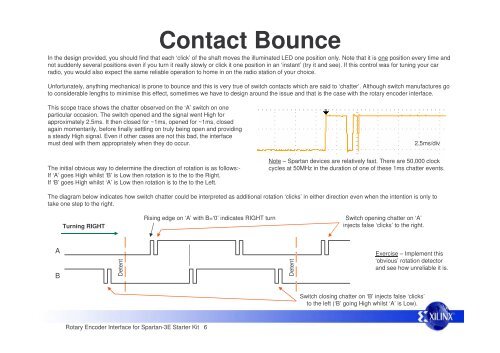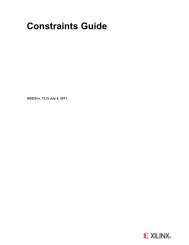Rotary Encoder Interface Spartan-3E Starter Kit
Rotary Encoder Interface Spartan-3E Starter Kit
Rotary Encoder Interface Spartan-3E Starter Kit
You also want an ePaper? Increase the reach of your titles
YUMPU automatically turns print PDFs into web optimized ePapers that Google loves.
This scope trace shows the chatter observed on the ‘A’ switch on one<br />
particular occasion. The switch opened and the signal went High for<br />
approximately 2.5ms. It then closed for ~1ms, opened for ~1ms, closed<br />
again momentarily, before finally settling on truly being open and providing<br />
a steady High signal. Even if other cases are not this bad, the interface<br />
must deal with them appropriately when they do occur.<br />
<strong>Rotary</strong> <strong>Encoder</strong> <strong>Interface</strong> for <strong>Spartan</strong>-<strong>3E</strong> <strong>Starter</strong> <strong>Kit</strong> 6<br />
Contact Bounce<br />
In the design provided, you should find that each ‘click’ of the shaft moves the illuminated LED one position only. Note that it is one position every time and<br />
not suddenly several positions even if you turn it really slowly or click it one position in an ‘instant’ (try it and see). If this control was for tuning your car<br />
radio, you would also expect the same reliable operation to home in on the radio station of your choice.<br />
Unfortunately, anything mechanical is prone to bounce and this is very true of switch contacts which are said to ‘chatter’. Although switch manufactures go<br />
to considerable lengths to minimise this effect, sometimes we have to design around the issue and that is the case with the rotary encoder interface.<br />
The initial obvious way to determine the direction of rotation is as follows:-<br />
If ‘A’ goes High whilst ‘B’ is Low then rotation is to the to the Right.<br />
If ‘B’ goes High whilst ‘A’ is Low then rotation is to the to the Left.<br />
The diagram below indicates how switch chatter could be interpreted as additional rotation ‘clicks’ in either direction even when the intention is only to<br />
take one step to the right.<br />
A<br />
B<br />
Turning RIGHT<br />
Detent<br />
Note – <strong>Spartan</strong> devices are relatively fast. There are 50,000 clock<br />
cycles at 50MHz in the duration of one of these 1ms chatter events.<br />
Rising edge on ‘A’ with B=‘0’ indicates RIGHT turn Switch opening chatter on ‘A’<br />
injects false ‘clicks’ to the right.<br />
Detent<br />
Switch closing chatter on ‘B’ injects false ‘clicks’<br />
to the left (‘B’ going High whilst ‘A’ is Low).<br />
2.5ms/div<br />
Exercise – Implement this<br />
‘obvious’ rotation detector<br />
and see how unreliable it is.












